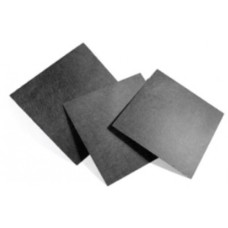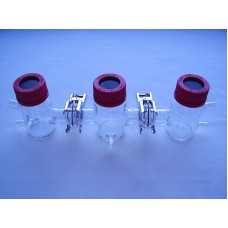Brennstoffzellen


Brennstoffzellen sind eine spezielle Art von galvanischen Zellen. Sie können mit festem, flüssigem oder gasförmigem Brennstoff betrieben werden. Die elektrochemische Oxidation des Brennstoffs ist mit Energiegewinn gekoppelt, der in Form von Elektrizität - im Gegensatz zur Wärme während der chemischen Oxidation - aufgenommen wird. Daher sind Brennstoffzellen direkte Energiewandler mit hoher Effizienz. Die meisten Brennstoffzellen erreichen eine Energieumwandlungseffizienz von 70-90%. Wenn die Umwandlung 100% beträgt, wird keine Abwärme erzeugt. Dieser ideale Fall der Energieumwandlung wird als "kalte Verbrennung" bezeichnet, die 1955 von Justi & Winsel erstmals demonstriert wurde. Der Brennstoff für diesen Prozess ist Wasserstoffgas, H2. Es tritt in eine poröse Nickelröhre (Gasdiffusionselektrode) ein, wo es in Protonen und Elektronen dissoziiert wird gemäß:
H2 → 2 H+ + 2 e-
Wasserstoff (H2 ) und Sauerstoff (O2 ) werden in die Brennstoffzelle gepumpt, wo sie durch zwei Elektroden und das Elektrolyt zu Wasser verbrannt werden. Während der Desorption setzt jedes H-Atom ein Proton (H+ ) und ein Elektron (e- ) frei. Das Elektron wird auf die Elektrode, Anode genannt, und das Proton in den Elektrolyten entladen. Als Ergebnis des Dissoziationsprozesses wird die Anode negativ geladen. Auf der zweiten Elektrode, Kathode genannt, wird dann Sauerstoffgas O2 mit dem Elektron geladen und in O2- -Ionen umgewandelt. Die Kathode wird positiv geladen. Beide Elektroden sind in Elektrolyten eingetaucht, in den meisten Fällen eine Kaliumhydroxid, KOH, Lösung von Wasser. Im Elektrolyt sind Kationen (H+ ) und Anionen (O2-) bilden Wasser durch chemische Fusion. Theoretisch beträgt der Wirkungsgrad 92%, begleitet von geringer Abwärme - im Gegensatz zur normalen Verbrennung, bei der Wärme von ~ 3.000ºC erzeugt wird.2 H2 + O2 → H2O
Es gibt verschiedene Arten von Brennstoffzellen, aber alle haben gemeinsam, dass sie aus Elektroden für die Brennstoff- und O2 -Aktivierung und elektrolytischen Leitern zwischen diesen Elektroden bestehen. Neuere Variationen von Brennstoffzellen umfassen Methanbrennstoffzellen und mikrobielle Brennstoffzellen. Aufgrund der hohen Aktivierungsenergie von Methan arbeiten Methanbrennstoffzellen üblicherweise bei hohen Temperaturen unter Verwendung von Festelektrolyten. Mikrobielle Brennstoffzellen verwenden Mikroben als anodischen Katalysator und organisches Material in Wasser als Brennstoff. Dies macht sie ideal für die Abwasserbehandlung.Im Gegensatz zu Wärmekraftgeneratoren erzielen Brennstoffzellen einen hohen Wirkungsgrad bei der direkten Energieumwandlung, da sie den zusätzlichen Schritt der Wärmeerzeugung vermeiden. Neben der Abkürzung der Wärmeerzeugung arbeiten Brennstoffzellen ohne mechanische Teile und geben keine Geräusche, Rauchgase oder Radioaktivität ab, wodurch sie in den Fokus zukünftiger Entwicklungen gerückt werden. Brennstoffzellen sind aufgrund ihrer hohen Energieeffizienz und der hohen Energiedichte von Wasserstoff ideal für Elektrofahrzeuge. In der Raumfahrt wurden Brennstoffzellen erstmals während des Apollo-Programms zwischen 1968 und 1972, im Skylab-Projekt 1973, im Apollo-Soyus-Programm, im Space-Shuttle-Programm und an Bord der Internationalen Raumstation eingesetzt. Dort liefern sie die elektrische Energie für Werkzeuge und Wasseraufbereitung. Ein Vorteil ist, dass das Endprodukt der Kaltverbrennung in Brennstoffzellen darin besteht, dass Wasser das Endprodukt ist, das Astronauten auf ihren Missionen verwenden.
Suche eingrenzen
Alkohol-Brennstoffzellen-Baukasten, Horizon
Der Alkohol-Brennstoffzellen-Baukasten benutzt Ethanol also Brennstoff. Durch chemische Oxidation wi..
534,31€ Netto 449,00€
ELAT - Hydrophiles Kohlenstofftuch
ELAT hydrophiles einfaches Kohlenstofftuch. Diese Gasdiffusionsschichten (GDS) eignen sich hervorrag..
197,54€ Netto 166,00€
Gasdiffusionssystem AvCarb GDS2230 P75
Das Gasdiffusionssystem GDS2230 P75 der AvCarb Material Solution kombiniert AvCarbs patentiertes Koh..
154,70€ Netto 130,00€
Gasdiffusionssystem AVCARB® MGL190
AVCARB® 190 ist ein hervorragendes Kohlenstoffpapier für Brennstoffzellen- und Elektrolyatoranwend..
208,25€ Netto 175,00€
Gasdiffusionssystem AVCARB® MGL370
AVCARB® MGL370 ist ein hervorragendes Kohlenstoffpapier für Brennstoffzellen- und Elektrolyatoranw..
214,20€ Netto 180,00€
Kohlenstofftuch, Gasdiffusionsschicht, ELAT LT1400
Die ELAT® LT1400 ist eine Kohlenstofftuch-Gasdiffusionsschicht (GDS) mit einer mikroporösen Kohlenst..
214,20€ Netto 180,00€
Kohlepapier, Freudenberg H14C7
Freudenberg H14C7 ist eine flexible und einfach zu verwendende Gasdiffusionsschicht (GDL) aus Kohlen..
428,40€ Netto 360,00€
Platinierter Titanschirm
Platinierte Titansiebe (Pt/Ti) werden hauptsächlich in Elektrolyseuren als Teil des Strömungsfelds o..
416,50€ Netto 350,00€
Butylgummiseptum, GL 45, 6 mm Stärke, schwarz
Glattes ButylkautschukseptumMaterial: ButylkautschukStruktur: ohneFarbe: schwarzStärke: 6 mmDurchmes..
2,96€ Netto 2,49€
Butylkautschukmatte, 6 mm
Glatte ButylgummimatteMaterial: ButylkautschukStruktur: ohneFarbe: schwarzStärke: 6 mmAbmessung: 100..
5,94€ Netto 4,99€
Dreikammer-mikrobielle-Brennstoffzelle (MBZ)
Dreikammer-mikrobielle-Brennstoffzelle mit drei GL14 Anschlüssen pro Kammer und Zwischenkammer. Die ..
1.547,00€ Netto 1.300,00€
Frontcell© Skalierbarer Mehrkanalpotentiostat
Der Frontcell© Mehrkanal-Potentiostat ist ein softwarebasierter Potentiostat, mit dem Sie unabhängig..
2.374,05€ Netto 1.995,00€
Gasdiffusionselektroden-Bausatz, GDE-Kit
Der Gasdiffusionelektroden-Bausatz (auch als GDE Kit bekannt) enthält 5 verschiedene mit Platin besc..
797,30€ Netto 670,00€
Kohlenstoffpapier, Sigracet 22 BB
Sigracet 22 BC ist ein Kohlenstoffpapier, das nicht gewebt ist und mit einer mikroporösen Schicht (M..
107,10€ Netto 90,00€
Kohlenstoffpapier, Sigracet 29 BC
Dieses Produkt ist nur noch begrenzt verfügbar und wurde durch Sigracet 22 BB ersetzt.Sigracet 29 BC..
208,25€ Netto 175,00€













